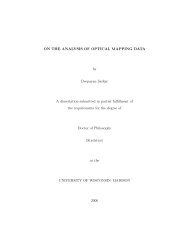Tiling Manifolds with Orthonormal Basis - Department of Statistics ...
Tiling Manifolds with Orthonormal Basis - Department of Statistics ...
Tiling Manifolds with Orthonormal Basis - Department of Statistics ...
You also want an ePaper? Increase the reach of your titles
YUMPU automatically turns print PDFs into web optimized ePapers that Google loves.
10<br />
The spherical harmonic (SPHARM) representation models the surface coordinates<br />
<strong>with</strong> respect to a unit sphere as<br />
p(θ, ϕ) =<br />
k∑<br />
l∑<br />
l=0 m=−l<br />
p 0 lm Y lm(θ, ϕ) (12)<br />
where p 0 lm = 〈p, Y lm〉 S 2 are spherical harmonic coefficients, which can be viewed<br />
as random variables. The coefficients are estimated using the iterative residual<br />
fitting algorithm [3] that breaks a larger least squares problem into smaller ones<br />
in an iterative fashion. The MATLAB code for performing the iterative residual<br />
fitting algorithm for arbitrary surface mesh is given in http://www.stat.wisc.edu<br />
/∼mchung/s<strong>of</strong>twares/weighted-SPHARM/weighted-SPHARM.hmtl. Note that all MRIs<br />
were reoriented to the pathological plane guaranteeing an approximate global<br />
alignment before the surface flattening to increase the robustness <strong>of</strong> the coefficient<br />
estimation.<br />
The shortcoming <strong>of</strong> the spherical harmonic representation is that the reconstruction<br />
is respect to a unit sphere that is not geometrically related to the<br />
original anatomical surface. On the other hand, the pullback representation will<br />
reconstruct the surface <strong>with</strong> respect to the average template surface reducing<br />
substantial amount <strong>of</strong> variability compared to SPHARM.<br />
In the pullback representation, we represent the surface coordinates <strong>with</strong><br />
respect to the template surface M as<br />
p(θ, ϕ) =<br />
k∑<br />
l∑<br />
l=0 m=−l<br />
p 1 lm Z lm(θ, ϕ) (13)<br />
<strong>with</strong> p 1 lm = 〈p, Z lm〉 M . Then we claim that the pullback representation has<br />
smaller variance in the estimated coefficients so that<br />
Var(p 1 lm) ≤ Var(p 0 lm). (14)<br />
The equality in (14) is obtained when the template M becomes the unit sphere,<br />
in which case the spherical mapping ζ collapses to the identity, and the inner<br />
products coincide. We have computed the sample standard deviation <strong>of</strong><br />
Fourier coefficients for 47 subjects using the both representations. In average, the<br />
SPHARM contains 88% more intersubject variability compared to the pullback<br />
representation (Figure 6 right). This implies that SPHARM is an inefficient representation<br />
and requires more number <strong>of</strong> basis to represent surfaces compared<br />
to the pullback method.<br />
Although the pullback method is more efficient, the both representations<br />
(12) and (13) converge to each other as k goes to infinity. We have computed the<br />
squared Euclidean distance between two representations numerically (Figure 7).<br />
In average, the difference is 0.0569 mm for 20 degree representation negligible for<br />
1mm resolution MR. Figure 7 also visually demonstrate that the pullback representation<br />
converges to the true manifold faster than SPHARM again showing<br />
the inefficiency <strong>of</strong> the SPHARM representation.
















